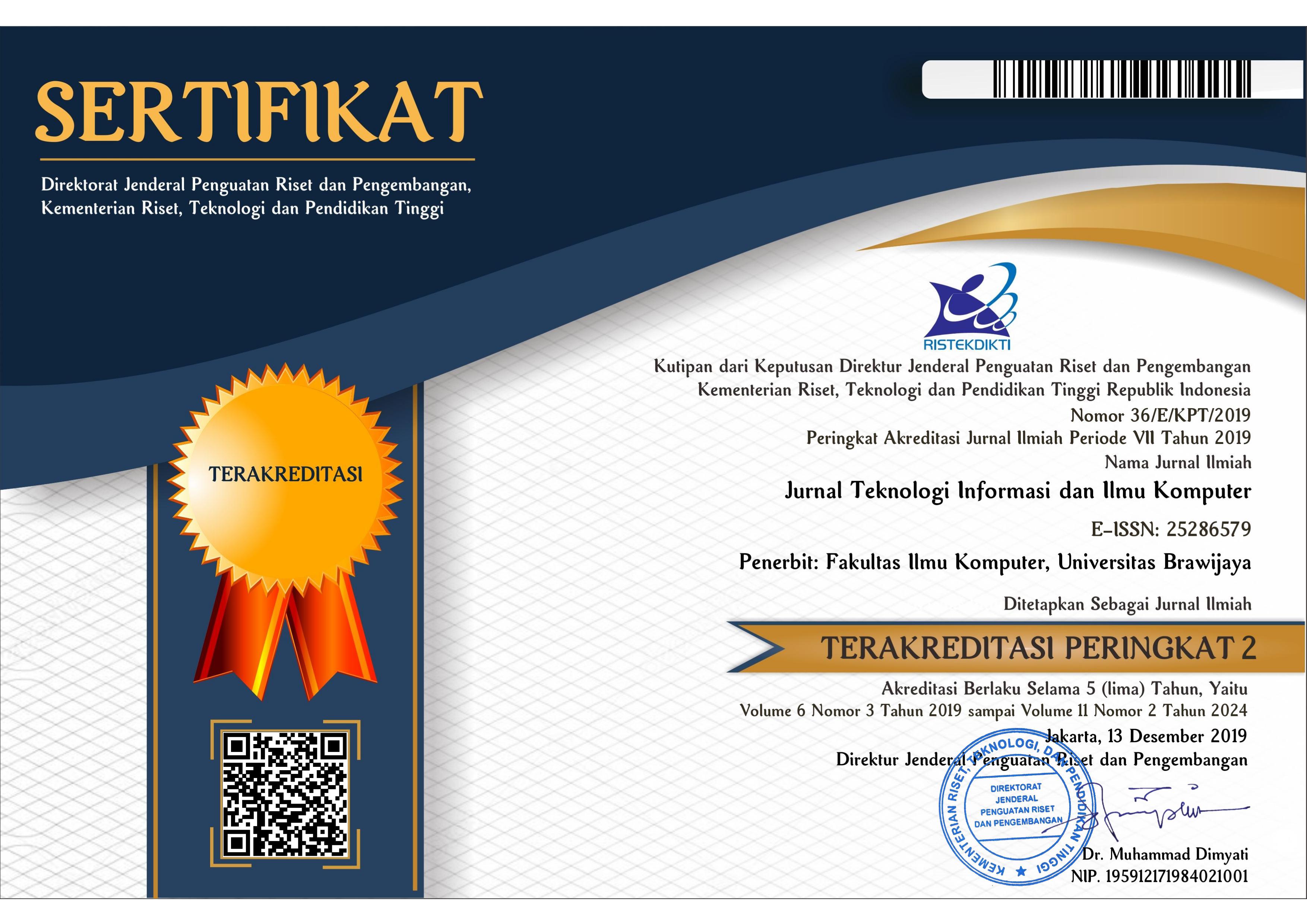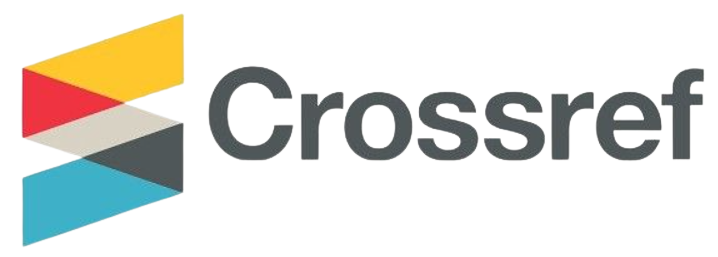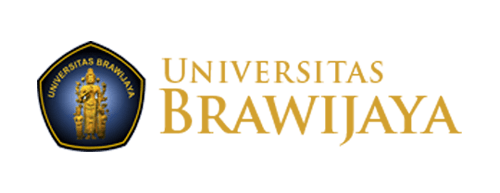Persepsi Kesesuaian dan Kepuasan Penggunaan Media Sosial pada Perkuliahan: Pengujian Model
DOI:
https://doi.org/10.25126/jtiik.201856907Kata Kunci:
model kepuasan, kesesuaian, media sosial, adopsi teknologiAbstrak
Penerimaan teknologi merupakan faktor penting, untuk keberlanjutan penggunaan sebuah teknologi. Model-model pengukuran telah banyak dikembangkan, namun belum mempertimbangkan kesesuaian dan kepuasan dalam penggunaan teknologi berkelanjutan. Pada penelitian yang sebelumnya penulis telah mengembangkan model kepuasan dan kesesuaian (Task-fit and Satisfaction Model) untuk mengidentifikasi persepsi dosen terhadap kesesuaian dan kepuasan penggunaan facebook sebagai sarana komunikasi dan informasi pada perkuliahan, namun belum diuji. Artikel ini menyajikan proses pengujian terhadap model tersebut. Responden penelitian ini adalah dosen di indonesia khususnya yang menggunakan facebook. Data penelitian dikumpulkan dengan menggunakan metode survey online. Metode Structural Equation Modeling (SEM) dan Partial Least Square (PLS) digunakan untuk analisis data. Hasil pengujian hipotesis memperlihatkan perceived task-fit, utilization dan satisfaction secara signifikan mempengaruhi continuance intention. Pengujian juga memperlihatkan bahwa Perceived task fit , confirmation, dan Service quality secara signifikan mempengaruhi satisfaction. Terdapat korelasi positif perceived task-fit terhadap utilization, dan service quality terhadap confirmation. Sedangkan pengujian coefficient of determination (R2), memperlihatkan continuance intention memperoleh nilai R2= 0.723, hal ini menunjukkan bahwa perentasi besarnya kemampuan model dalam memprediksi persepsi kesesuaian dan kepuasan dosen terhadap penggunaan facebook dalam perkuliahan sebesar 72.3%.
Abstract
Acceptance of technology is an important factor, for the continued use of a technology. Measurement models have been developed, but not many consider perceived of fitness and satisfaction in receiving technology. In the previous research the authors has developed a Task-fit and Satisfaction Model to identify lecturers' perceptions of the suitability and satisfaction of facebook usage as a means of communication and information on lectures, the model have not test yet. This paper aim to present the testing process for this model. Responden this research is a lecturer in Indonesia especially who use facebook. Data collected by online survey method. SEM with PLS approach used to data analysis. The results of hypothesis testing show that perceived task-fit, utilization and satisfaction significantly influence continuance intention. The results also show that Perceived task fit, confirmation, and Service quality significantly affect satisfaction. There is a positive correlation of perceived task-fit to utilization, and service quality to confirmation. While the coefficient of determination test, shows continuance intention obtained the value of R2 = 0.723, This shows that the magnitude of the model's ability to predict perceptions of fitness and lecturer satisfaction towards the use of Facebook in lectures is 72.3%.
Downloads
Referensi
ADAMOVIC, D., POTGIETER, A., & MEARNS, M. (2012). Knowledge sharing through social media: Investigating trends and technologies in a global marketing and advertising research company. SA Journal of Information Management, 14(1), 1–7. https://doi.org/10.4102/sajim.v14i1.514
AKCAOGLU, M., & DAVID, N. (2016). Using instructor-led Facebook groups to enhance students ’ perceptions of course content. Computers in Human Behavior, 1–9. https://doi.org/10.1016/j.chb.2016.05.029
BHATTACHERJEE, A. (2001). Understanding Information Systems Continuance: An Expectation-Confirmation Model. Anol Bhattacherjee Source: MIS Quarterly, 25(3), 351–370. https://doi.org/10.2307/3250921
BUHI, E. R., GOODSON, P., & NEILANDS, T. B. (2007). Structural Equation Modeling : A Primer for Health Behavior Researchers Objective : To introduce the state, 74–85.
CHEOK, M. L., & WONG, S. L. (2015). Predictors of E-Learning Satisfaction in Teaching and Learning for School Teachers : A Literature Review. International Journal of Instruction, 8(1), 75–90.
CHIN, W. W. (1998). The Partial Least Squares approach to Structural.
CRONBACH, L. J. (1951). Coefficient Alpha and The Internal Structure of Tests. Psychometrika, 16(3), 297–334.
DELONE, W. H., & MCLEAN, E. R. (2003). The DeLone and McLean Model of Information Systems Success : A Ten-Year Update, 19(4), 9–30.
DRAGANA, Z., ARSIC, S., MANASIJEVIC, D., & MILOŠEVIC, I. (2015). Telematics and Informatics Facebook as virtual classroom – Social networking in learning and teaching among Serbian students ˇ ivkovic, (February). https://doi.org/10.1016/j.tele.2015.02.003
FORNELL, C., & LARCKER, D. F. (1981). (1981). Evaluating Structural Equation Models with Unobservable Variables and Measurement Error. Journal of Marketing, 18, 39–50.
GOODHUE, L., D., & THOMPSON, R. L. (1995). Task-technology fit and individual performance, 3439.
HERLAMBANG, A. D., & HIDAYAT, W. N. (2016). Edmodo Untuk Meningkatkan Kualitas Perencanaan Proyek Dan Efektivitas Pembelajaran Di Lingkungan Pembelajaran Yang Bersifat Asinkron. Jurnal Teknologi Informasi Dan Ilmu Komputer, 3(3), 180. https://doi.org/10.25126/jtiik.201633193
HEW, K. F. (2011). Students ’ and teachers ’ use of Facebook, 27, 662–676. https://doi.org/10.1016/j.chb.2010.11.020
HOLZINGER, A., SEARLE, G., & WERNBACHER, M. (2011). The effect of previous exposure to technology on acceptance and its importance in usability and accessibility engineering. Universal Access in the Information Society, 10(3), 245–260. https://doi.org/10.1007/s10209-010-0212-x
HOOPER, D., MULLEN, J., HOOPER, D., COUGHLAN, J., & MULLEN, M. R. (2008). " Structural Equation Modelling: Guidelines for Determining Model Fit Structural Equation Modelling: Guidelines for Determining Model Fit. The Electronic Journal of Business Research Methods, 6(1), 53–60. Retrieved from www.ejbrm.com
KOPECKY, K. (2016). Telematics and Informatics Czech Children and Facebook – A quantitative survey q, 33, 950–958. https://doi.org/10.1016/j.tele.2016.02.008
KUMAR, S., JOSHI, A., & SHARMA, H. (2016). A multi-analytical approach to predict the Facebook usage in higher education. Computers in Human Behavior, 55, 340–353. https://doi.org/10.1016/j.chb.2015.09.020
LAMBIC, D. (2016). Correlation between Facebook use for educational purposes and academic performance of students, 61, 313–320. https://doi.org/10.1016/j.chb.2016.03.052
LEWIS, B. R., TEMPLETON, G. F., & BYRD, T. A. (2005). A methodology for construct development in MIS research, (May 2004), 388–400. https://doi.org/10.1057/palgrave.ejis.3000552
LIAO, C., CHEN, J. L., & YEN, D. C. (2007). Theory of planning behavior (TPB) and customer satisfaction in the continued use of e-service: An integrated model. Computers in Human Behavior, 23(6), 2804–2822. https://doi.org/10.1016/j.chb.2006.05.006
LIN, W. S. (2012). Perceived fit and satisfaction on web learning performance: IS continuance intention and task-technology fit perspectives. International Journal of Human Computer Studies, 70(7), 498–507. https://doi.org/10.1016/j.ijhcs.2012.01.006
PATRICKS, A., LIBAQUE-SAENZ, C. F., FAN, S., & CHANG, Y. (2016). Telematics and Informatics An expectation-confirmation model of continuance intention to use mobile instant messaging. TELEMATICS AND INFORMATICS, 33(1), 34–47. https://doi.org/10.1016/j.tele.2015.05.006
PETTER, S., DELONE, W., & MCLEAN, E. (2008). Measuring information systems success: models, dimensions, measures, and interrelationships. European Journal of Information Systems, 17(3), 236–263. https://doi.org/10.1057/ejis.2008.15
PRADANA, F., RACHMADI, A., & BACHTIAR, F. A. (2015). Penilaian Faktor Penerimaan Teknologi Blended learning di PTIIK Universitas Brawijaya dengan Metode Unified Theory of Acceptance and Use of Technology (UTAUT). Jurnal Teknologi Informasi Dan Ilmu Komputer, 2(1), 49. https://doi.org/10.25126/jtiik.201521130
SHIAU, W., HUANG, L., & SHIH, C. (2011). Understanding Continuance Intention of Blog Users : A Perspective of Flow and Expectation Confirmation Theory, 6(4), 306–317. https://doi.org/10.4156/jcit.vol6.
SILIUS, K., KAILANTO, M., & TERVAKARI, A. M. (2011). Evaluating the quality of social media in an educational context. International Journal of Emerging Technologies in Learning, 6(3), 21–27. https://doi.org/10.1109/EDUCON.2011.5773183
STRAUB, D., BOUDREAU, M.-C., & GEFEN, D. (2004). Validation Guidelines for IS Positivist Research Validation Guidelines for IS Positivist Research. The Communications of the Association for Information Systems, 13.1(c), 63.
TANEJA, A., VITRANO, J., & GENGO, N. J. (2014). Rationality-based beliefs affecting individual’s attitude and intention to use privacy controls on Facebook: An empirical investigation. Computers in Human Behavior, 38, 159–173. https://doi.org/10.1016/j.chb.2014.05.027
TESS, P. A. (2013). The role of social media in higher education classes ( real and virtual ) – A literature review. Computers in Human Behavior, 29(5), A60–A68. https://doi.org/10.1016/j.chb.2012.12.032
URBACH, N., & AHLEMANN, F. (2010). Structural Equation Modeling in Information Systems Research Using Partial Least Squares. Journal of Information Technology Theory and …, 11(2). Retrieved from http://iris.ebs.edu/accessdb/WWW/iris_pub_web.nsf/wwwPublAuthorSingleEng/A58520D5E3C484DCC1257C50007F8697/$file/Urbach et al. 2010 Structural Equation Modeling in IS Research Using PLS.pdf
VENKATESH, V., THONG, J. Y. L., CHAN, F. K. Y., HU, P. J.-H., & BROWN, S. A. (2011). Extending the two-stage information systems continuance model: incorporating UTAUT predictors and the role of context. Information Systems Journal, 21(6), 527–555. https://doi.org/10.1111/j.1365-2575.2011.00373.x
YEN, D. C., WU, C. S., CHENG, F. F., & HUANG, Y. W. (2010). Determinants of users’ intention to adopt wireless technology: An empirical study by integrating TTF with TAM. Computers in Human Behavior, 26(5), 906–915. https://doi.org/10.1016/j.chb.2010.02.005
ZIVKOVI, D., ARSI, S., & MILO, I. (2016). Exploring students ’ purposes of usage and educational usage of Facebook, 60. https://doi.org/10.1016/j.chb.2016.02.087
Unduhan
Diterbitkan
Terbitan
Bagian
Lisensi

Artikel ini berlisensi Creative Common Attribution-ShareAlike 4.0 International (CC BY-SA 4.0)
Penulis yang menerbitkan di jurnal ini menyetujui ketentuan berikut:
- Penulis menyimpan hak cipta dan memberikan jurnal hak penerbitan pertama naskah secara simultan dengan lisensi di bawah Creative Common Attribution-ShareAlike 4.0 International (CC BY-SA 4.0) yang mengizinkan orang lain untuk berbagi pekerjaan dengan sebuah pernyataan kepenulisan pekerjaan dan penerbitan awal di jurnal ini.
- Penulis bisa memasukkan ke dalam penyusunan kontraktual tambahan terpisah untuk distribusi non ekslusif versi kaya terbitan jurnal (contoh: mempostingnya ke repositori institusional atau menerbitkannya dalam sebuah buku), dengan pengakuan penerbitan awalnya di jurnal ini.
- Penulis diizinkan dan didorong untuk mem-posting karya mereka online (contoh: di repositori institusional atau di website mereka) sebelum dan selama proses penyerahan, karena dapat mengarahkan ke pertukaran produktif, seperti halnya sitiran yang lebih awal dan lebih hebat dari karya yang diterbitkan. (Lihat Efek Akses Terbuka).












